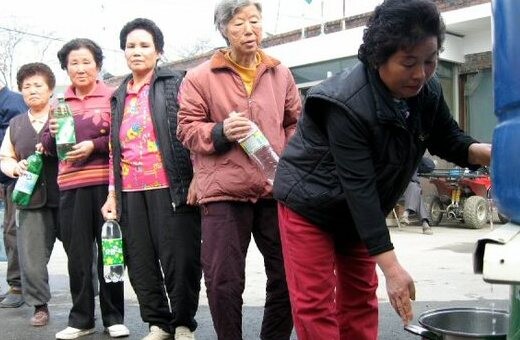hankyoreh
Links to other country sites 다른 나라 사이트 링크
High levels of uranium, radon found in water supply

A survey conducted by the Ministry of Environment last year showed that up to 1,640 micrograms per liter of uranium - or 54.6 times higher than the U.S. maximum safe level (there is no standard in Korea) - had been detected in the water supply of a village near Icheon, Gyeonggi Province.
Moreover, it was confirmed that a resident of this village had as much as 302 times this maximum level in his body.
Beginning in July last year, the ministry performed a six-month survey of groundwater in 93 locations nationwide. It announced on February 21 that uranium figures exceeded the U.S. standard in one village, Jangpyeong-ri, near Icheon.
After 1,640㎍/ℓ uranium, 54.6 times the U.S. standard, was detected in the water supply there, the water was declared unpotable.
But one Jangpyeong-ri resident had unwittingly stumbled upon the uranium problem earlier than this. A 40-year-old resident, identified as Mr. Jang, said that he had been suffering from fatigue, headaches, and vomiting since February 2001. During a medical checkup in September last year, his doctor took a hair sample and sent it to Trace Elements, a private laboratory in the United States. According to the laboratory’s report, Jang’s body contained uranium as much as 302 times the U.S. maximum safe level. However, the laboratory’s report said that "the detected uranium would not affect human health because its radioactivity is very weak."
However, even if the radioactivity levels of the uranium in Jang’s body are weak, uranium is known to be harmful to the kidneys when ingested in large quantities. Furthermore, the test measured only one isotope, U-238, the weakest of the three primarily occuring uranium isotopes in terms of radioactivity, meaning the levels could in fact be higher. And though Mr. Jang has since recovered from his symptoms, the cause of his illness is still unknown.
Given both their discovery of high amounts of uranium in the village’s water supply and the revealation of Jang’s uranium level, the Ministry of Environment plans to perform epidemiological examinations on about 180 residents who have been drinking the water for over a decade to ascertain the effects of exposure. The ministry has requested the National Institute of Environmental Research to be responsible for the examinations on their behalf.
In the U.S. lab’s examination of Jang’s hair sample, other heavy metals such as mercury, cadmium, lead, and aluminum were either absent or at safe levels.
In addition to the discovery of uranium in the water supply, the ministry’s survey last year found that up to 32,600 picocuries/liter of radon existed in the water supply of 22 villages nationwide, eight times higher than the maximum safe level per U.S. standards. Safe levels of radon existed in the water supply of 24 regions. The picocurie is a standard measure of the intensity of radioactivity: one picocurie represents 2.2 disintegrations per minute per one gram of material; in comparison, radium decays at a rate of about 2.2 trillion disintegrations per minute. Overexposure to radon is known to cause fatal diseases such as lung and stomach cancer.
The ministry said the groundwater was contaminated by naturally occurring radioactive materials contained in soil or rocks.
Please direct questions or comments to [englishhani@hani.co.kr]
Editorial・opinion
![[Column] Has Korea, too, crossed the Rubicon on China? [Column] Has Korea, too, crossed the Rubicon on China?](https://flexible.img.hani.co.kr/flexible/normal/500/300/imgdb/original/2024/0419/9317135153409185.jpg) [Column] Has Korea, too, crossed the Rubicon on China?
[Column] Has Korea, too, crossed the Rubicon on China?![[Correspondent’s column] In Japan’s alliance with US, echoes of its past alliances with UK [Correspondent’s column] In Japan’s alliance with US, echoes of its past alliances with UK](https://flexible.img.hani.co.kr/flexible/normal/500/300/imgdb/original/2024/0419/2317135166563519.jpg) [Correspondent’s column] In Japan’s alliance with US, echoes of its past alliances with UK
[Correspondent’s column] In Japan’s alliance with US, echoes of its past alliances with UK- [Editorial] Does Yoon think the Korean public is wrong?
- [Editorial] As it bolsters its alliance with US, Japan must be accountable for past
- [Guest essay] Amending the Constitution is Yoon’s key to leaving office in public’s good graces
- [Editorial] 10 years on, lessons of Sewol tragedy must never be forgotten
- [Column] A death blow to Korea’s prosecutor politics
- [Correspondent’s column] The US and the end of Japanese pacifism
- [Guest essay] How Korea turned its trainee doctors into monsters
- [Guest essay] As someone who helped forge Seoul-Moscow ties, their status today troubles me
Most viewed articles
- 1[Column] The clock is ticking for Korea’s first lady
- 2Hong Se-hwa, voice for tolerance whose memoir of exile touched a chord, dies at 76
- 3After 2 months of delayed, denied medical care, Koreans worry worst may be yet to come
- 4[Column] Has Korea, too, crossed the Rubicon on China?
- 5Samsung barricades office as unionized workers strike for better conditions
- 6US overtakes China as Korea’s top export market, prompting trade sanction jitters
- 7All eyes on Xiaomi after it pulls off EV that Apple couldn’t
- 8[Guest essay] How Korea turned its trainee doctors into monsters
- 9[Editorial] As it bolsters its alliance with US, Japan must be accountable for past
- 10[Correspondent’s column] In Japan’s alliance with US, echoes of its past alliances with UK